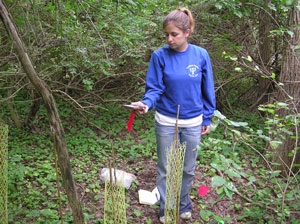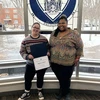|
Lindsay Martin is shown collecting data on invasive plant species found in Chautauqua County. |
Lindsay Martin of Fredonia was one of five students who won Holmburg Summer Research Awards from the Holmburg Foundation of Jamestown this year. The awards included $2,500 in stipends for each student, and equipment expenses.
Working with biology professor Jon Titus, Ms. Martin collected data at the Bentley Preserve in Jamestown, N.Y., to help understand the effects of two non-native plant invaders (Japanese Knotweed and Garlic Mustard) on Western New York plant communities.
"A major cause of species extinction is non-native species invasions," Dr. Titus said. "We are more succesful controlling them when a thorough knowledge of the biology of the species is known."
Garlic mustard outcompetes native species and reduces the diversity and habitat value of forest understories.
At Bentley Preserve, Ms. Martin helped establish 24 plotted areas in dense garlic mustard stands, and removed garlic mustard from 12 of the plots. Another 12 pots were nearby but not yet invaded. "We're using these plots to monitor species response and to examine the effect of garlic mustard on arbuscular mycorrhizal fungi.
Greenhouse experiments in Jewett Hall will also be conducted looking at competition between garlic mustard and native forbs while manipulating mycorrhizal fungi levels," Dr. Titus said.
Riparian (see the definition of riparian here) forests are at risk because trees appear not to regenerate in Japanese knotweed stands that dominate many riparian zones.
In a local riparian zone, Dr. Titus and students established 18 plots, 12 of which were located in dense Japanese knotweed stands and the Japanese knotweed was cut in six of these plots. The other 6 plots were located in adjacent non-invaded areas. Plots are being monitored for species response and native species are being planted in these plots.
"By planting species in these plots, it will be seen if riparian forest species can be maintained by planting in areas where the knotweed has been cut," Dr. Titus said.




